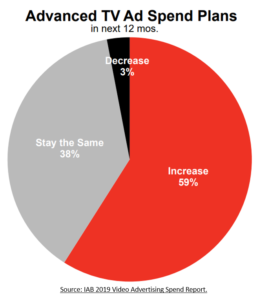“Remember: all I’m offering is the truth. Nothing more.”
With that line, Morpheus convinced Neo to enter the Matrix and there was no going back. And so by coming to this web site and reading this sentence right now, you too are faced with an equally important decision. Should you enter the Matrix (of Advanced TV)?
To be clear, it’s not a world of IAB’s or any one of our member’s making. Advanced TV is actually an umbrella term that refers to TV delivered and executed outside of the traditional linear television model. It includes for example, data-driven linear, on-demand and addressable forms of television, and of course the fast growing direct-to consumer streaming services delivered on Connected TV’s and other connected devices (colloquially known as “OTT” or “over-the-top”).
 At its core, Advanced TV utilizes a combination of data and technology to deliver TV advertising more precisely and relevantly to specific viewers at the household level. This promise of better targeting matters immensely to advertisers seeking to more effectively reach their target consumers with less waste. Indeed, nearly 60% of advertisers report that they will increase their budgets for Advanced TV this year.
At its core, Advanced TV utilizes a combination of data and technology to deliver TV advertising more precisely and relevantly to specific viewers at the household level. This promise of better targeting matters immensely to advertisers seeking to more effectively reach their target consumers with less waste. Indeed, nearly 60% of advertisers report that they will increase their budgets for Advanced TV this year.
Together, we and other members of the Advanced TV Working Group, have developed the “Advanced TV Matrix: A Market Snapshot”—a reference guide with the aim of organizing and simplifying the Advanced TV Landscape. This market snapshot can be used by media professionals of all kinds—planners, buyers (both TV and Digital), brands, or anyone in the video space—to sort out the confusion surrounding the new realm of TV offerings and how they compare to each other.
The TV industry has evolved enormously over the past five years. To many, the starting point is aligning on what “TV” is (or what many are now simply calling “Video”). We’re seeing the previously siloed worlds of linear TV and digital video coming closer and closer together, driven in part by buyer’s increasingly hybrid digital/linear budgets and the need for more unified multi-platform buying. In fact, more than 8 in 10 advertisers agree that a unified multi-platform buying solution (TV + digital video) is important, according to the IAB 2019 Video Advertising Spend Report. To complicate matters, fragmentation, scale, duplication, and data complexity create additional layers that need to be analyzed and accounted for. And if that weren’t enough, the currency in which “TV” (versus digital) is purchased and measured also varies. Ultimately, buyers are being challenged more and more to stay ahead of the curve and understand what’s real and executable as opposed to what’s just noise.
There are of course a number of advantages to Connected TV advertising, but it does come with a unique set of challenges. Publishers are struggling with the right way to monetize and buyers are struggling with how best to optimize this new medium. “CTV represents the best of the digital and traditional TV worlds that it intersects. Ads can be dynamically targeted to users while also benefiting from the TV glass shared viewing experience where the delivery of one ad has the ability to reach many” says Marissa McArdle, VP Digital Product Leadership at Nielsen. To address the challenges, there are three major collaborative concepts that Marissa suggests the industry rally around:
- An independent, cross-platform and cross-publisher measurement solution for CTV that leverages the Identifier for Advertising on Over-the-Top Video Platforms (IFA for OTT)
- A shift away from household-level targeting toward individual-level addressability within the household
- Industry-wide adoption of metrics that can be applied to both TV and Digital
Without these three concepts fully realized, Connected TV advertising’s potential will continue to be held back. “Adoption and creation of measurement standards will allow for consumers to take more control over their data, privacy, preferences, and ad experiences while offering the industry the ability to create fair and consistent measurement across platforms and publishers” Marissa continues. “Having industry adoption of common metrics (such as impressions, viewability, and duration thresholds) will help to bring us closer to actionable and accurate cross platform video measurement comparisons.”
Our hope with this guide is to offer—like Morpheus did with Neo—a lens through which to view the Advanced TV landscape. There’s a lot going on, but it’s important to enter with an open mind. We should no longer be doing things because “that’s the way we’ve always done them.” It might take time to learn some of the new ins and outs, but by gaining a more holistic view, you give yourself a chance to separate yourselves from the competition. Just like the Matrix, Advanced TV is changing all the time. The IAB Advanced TV Matrix is a product of the IAB Advanced TV Working Group. We invite you to join the conversation and be a part of the change. Find out more at iab.com or reach out at [email protected].
“Unfortunately, no one can be told what the Matrix is. You have to see it for yourself.”
CLICK HERE TO ENTER THE IAB ADVANCED TV MATRIX: A MARKET SNAPSHOT
Join 400+ attendees from across the digital marketing ecosystem at the inaugural IAB NexGen Marketing Conference and learn how modern marketers are utilizing data, mobile, and video-driven marketing strategies to increase consumer engagement and accelerate business growth.




